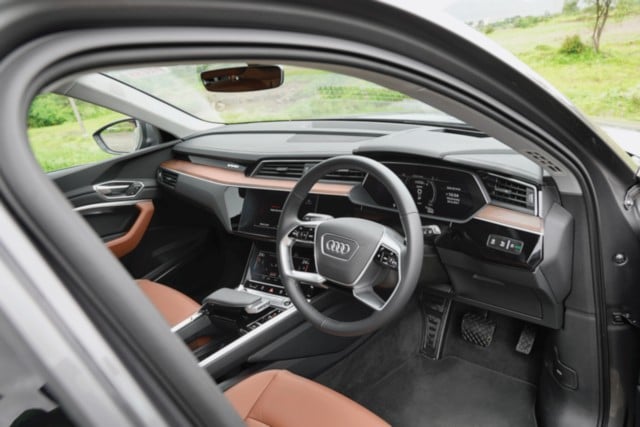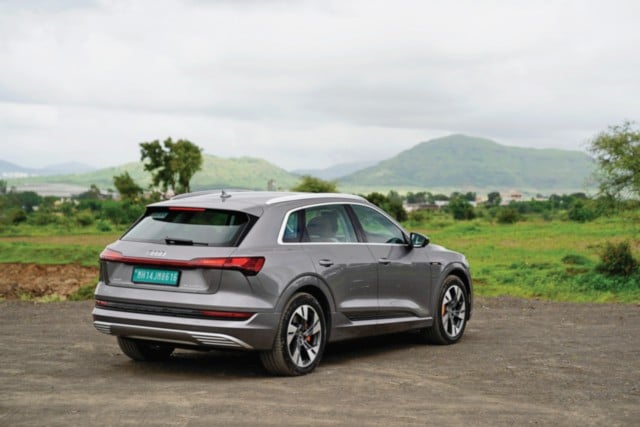The Audi e-tron 55 quattro is quick to set off and the range, as I set out, was 399 km. The very instant I tapped the “AC” button, the range immediately dropped to 353. Taken aback, I tapped it again to see “AC Eco” and the range go up to 362. Well, getting nine back is better than losing 46 km, yes? Audi claim that an 80 per cent charge can be achieved in 30 minutes using a high-voltage fast-charging point. However, there are two charging modes for those at home using trickle-charging: a 11-kW one tops up the car in about 8.5 hours, whereas the 22-kW system takes 4.5 hours. We only had the car for less than a day, so we couldn’t try out the ABB Formula-E style charging wallbox.

The WLTP range for the Audi e-tron 55 quattro is rated at between 369 and 441 km. However, in real-world traffic in Pune, with its stop-go nature and mixed road conditions, I saw 3.1 km/kWh or about 270 km of range until the 86-kWh bat-pack is depleted. Driven normally in non-peak traffic should see a range closer to the WLTP figure. The recuperation works best under hard braking but there are two levels available at a pull of the left paddle (no downshifts in here) and, then, the deceleration is very evident. However, maintaining speed is best done by using between 10 and 25 per cent of the right pedal — there’s a dial in the Classic and Sport mode display choices. The thing to note is that an EV doesn’t idle. It just switches off. However, the air-conditioning system and the very nice Bang & Olufsen premium sound still remain on and that takes battery power, too. In colder climates, without the climate control on, the entire set-up would stay cooler and, from my understanding, that’s a good thing and should translate into more driving range; closer to the upper WLTP rating of more than 400 km.

The “drive select” modes play a further role in the proceedings and prove that, here in India, it’s not just about range. In “efficiency” the five-level air suspension is at level two. That wasn’t enough to tackle the unthinkably ridiculous mound of tarmac that passes off as a speed-hump. The “allroad” and “offroad” modes help there, raising it to level four and five, respectively, but the latter also turns off the traction control. In level five, the ground clearance is a considerable 248 mm, more than enough for most purposes even after factoring in the 2.9-metre wheelbase. That said, the Audi e-tron and its rivals, the Jaguar I-Pace and Mercedes EQC, have something in common. They’re built for infrastructure where the term exceeds merely charging points. The quality of road surface, the size of speed-breakers, and the height of road shoulder, should one need to quickly swerve for whatever, all make a huge difference to the experience. The EV’s challenge has always been range and the stop-go conditions, which are prevalent most of the time here, make for a different sort of challenge.
The Audi e-tron 55 quattro is an extremely well-finished car. The quality of trim and upholstery — in fact, all of the material used inside — is of proper high quality and everything fits like a glove. It’s a refined and luxurious take on a practical body style. The ride is on the firmer side and, with the weight low down, the handling is rather good. The steering feel is not overly light and feels nice to hold on to. It has all the safety kit on board and that’s reassuring as well. The launch is set for 22 July and the price will be announced then. Expect a price tag of — or very close to — eight figures.

Need to Know – Audi e-tron 55 quattro
Price: Rs 1 crore (estimated)
Power: 360 hp (normal), 408 hp (peak)
Torque: 561 Nm (normal), 664 Nm (peak)
Transmission: Single-speed, automatic, front and rear
Battery: 95 kWh, 86 kWh usable
Range: 369-441 km (WLTP)
Weight: 2,520 kg




